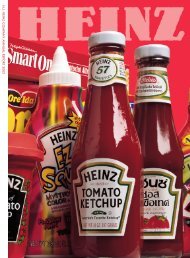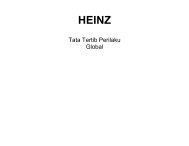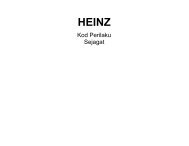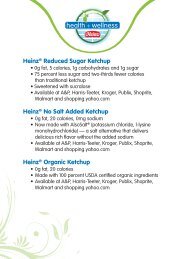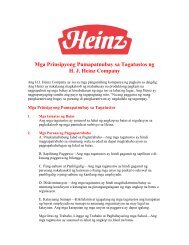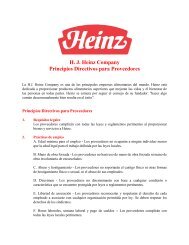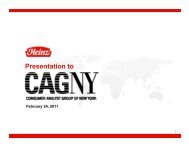Download Annual Report PDF - Heinz
Download Annual Report PDF - Heinz
Download Annual Report PDF - Heinz
You also want an ePaper? Increase the reach of your titles
YUMPU automatically turns print PDFs into web optimized ePapers that Google loves.
Gross profit decreased $44 million, or 11.1%, to $353 million, and the gross profit margin<br />
decreased to 24.3% from 26.7%, due to lower volume, higher commodity and manufacturing costs and<br />
Fiscal 2008 gains on commodity derivative contracts, partially offset by higher pricing. Operating<br />
income decreased $34 million, or 20.7%, to $129 million, which was primarily due to the decline in<br />
gross profit, partially offset by reduced G&A reflecting a gain in Fiscal 2009 on the sale of a small,<br />
non-core portion control business.<br />
Rest of World<br />
Sales for Rest of World increased $100 million, or 27.3%, to $468 million. Volume increased 4.6%<br />
driven by increases in Latin America and the Middle East. Higher pricing increased sales by 27.6%,<br />
largely due to inflation in Latin America and commodity-related price increases in South Africa and<br />
the Middle East. Acquisitions increased sales 0.2% due to the fourth quarter Fiscal 2009 acquisition<br />
of Papillon, a small chilled products business in South Africa. Foreign exchange translation rates<br />
decreased sales 5.2%.<br />
Gross profit increased $28 million, or 21.4%, to $161 million, due mainly to increased pricing and<br />
higher volume, partially offset by increased commodity costs and unfavorable foreign currency<br />
movements. Operating income increased $7 million, or 15.2% to $52 million due to the increase in<br />
gross profit partially offset by wage inflation in Latin America.<br />
Liquidity and Financial Position<br />
For Fiscal 2010, cash provided by operating activities was a record $1.26 billion compared to<br />
$1.17 billion in the prior year. The improvement in Fiscal 2010 versus Fiscal 2009 was generated<br />
despite significant contributions to our pension plans, and was primarily due to favorable movements<br />
in working capital and reduced tax payments. Additionally, $84 million of cash was received in the<br />
current year in connection with an accounts receivable securitization program (see additional<br />
explanations below), and the Company also received $48 million of cash from the termination of<br />
a total rate of return swap. In the prior year, the Company received $106 million of cash from the<br />
settlement and maturity of foreign currency contracts that were put in place to help mitigate the<br />
impact of translation associated with key foreign currencies (see Note 12, “Derivative Financial<br />
Instruments and Hedging Activities” in Item 8-“Financial Statements and Supplementary Data” for<br />
additional information). The Company’s cash conversion cycle improved 8 days, to 47 days in Fiscal<br />
2010. There was a 6 day improvement in inventories as a result of the Company’s efforts to reduce<br />
inventory levels. Receivables accounted for 5 days of the improvement, 4 days of which is a result of<br />
the accounts receivable securitization program. Accounts payable partially offset these improvements,<br />
with a 3 day decrease, a portion of which reflects inventory reductions and the resulting<br />
decrease in the amounts due to suppliers.<br />
During Fiscal 2010, the Company made $540 million of contributions to the pension plans<br />
compared to $134 million in the prior year. Of this $540 million of payments, $475 million were<br />
discretionary contributions that were made to help offset the impact of adverse conditions in the<br />
global equity and bond markets in Fiscal 2009. Contributions for Fiscal 2011 are expected to be less<br />
than $50 million; however, actual contributions may be affected by pension asset and liability<br />
valuations during the year.<br />
During the first quarter of Fiscal 2010, the Company entered into a three-year $175 million<br />
accounts receivable securitization program. Under the terms of the agreement, the Company sells, on<br />
a revolving basis, its U.S. receivables to a wholly-owned, bankruptcy-remote-subsidiary. This subsidiary<br />
then sells all of the rights, title and interest in these receivables to an unaffiliated entity. After<br />
the sale, the Company, as servicer of the assets, collects the receivables on behalf of the unaffiliated<br />
entity. The amount of receivables sold through this program as of April 28, 2010 was $84 million.<br />
Cash provided by investing activities totaled $13 million compared to using $761 million of cash<br />
last year. In the current year, proceeds from divestitures provided cash of $19 million which primarily<br />
23




